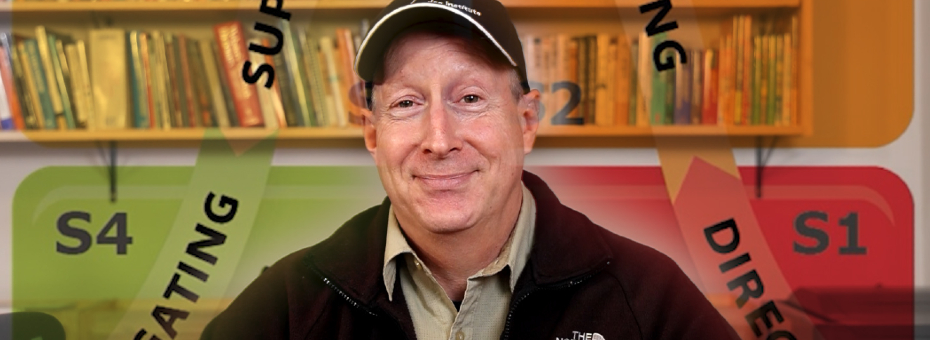Art Smalley delves more deeply into situational leadership in the third video of a five-part series.
Find the transcript for part three below.
Hi everyone. This is Art Smalley, President of Art of Lean, Incorporated. Today, on behalf of the Lean Enterprise Institute, I have another short video for you. This one continues on the theme of situational leadership.
In previous videos, we did a quick intro to the topic, and I shared with you what’s called the D1-S1 quadrant, where you supply good direction or directive style leadership. Today we’re going to bump that up to what situational leadership calls the D2 or S2 case where you actually employ coaching and I want to talk about what’s meant by the word coaching and the implications behind it. This quadrant is characterized by the nickname disillusioned or frustrated learner. I think many of you can relate to this. You probably try to debug your computer sometimes, or answer a complex question, or maybe like me, you’re juggling and you can’t get past that 10th or 12th ball for some reason.
Guidance Amid Disillusion
At some point, the newness and excitement wear off and you become the disillusioned learner. This is true for just about everything in life, even for employees and work in Toyota. I experienced that many times on many different projects in cases. D2 is characterized by some knowledge and skill, inconsistent performance, sometimes high, sometimes medium, sometimes low, and the reality you don’t know how to move forward. Okay, you’re stuck. You don’t know how to do the next step.
Next stage, you’re still looking for help or guidance. You’ve got most of the basics, but something’s holding you back. Additionally, it’s not just about skill. The D2 bucket is very much about will, okay. There’s an emotional component to this side of it because you’re feeling discouraged and frustrated, overwhelmed, demotivated, and you’re confused and probably even concerned about what to do and how other external conditions can come into play.
Now when confronted with this quadrant, the situational leadership model wants you to supply a higher degree of supportive leadership in addition to directive leadership. By supportive leadership, they mean embodying good empathy and understanding, looking at it from the learner’s perspective, their point of view. Why do they think it’s difficult? Why are they struggling? How does it feel? You want to let them know there’s a way forward, to have the confidence to go forward and try again. You want to let them know there’s a way forward, confidence to go forward and try again.Re-engage and keep going to get this be done. To do that, you have to, of course, first comfort them on the support side of it. And then go back to the details of the directive leadership, but more specific as a coach. It’s your responsibility to help them identify why they are struggling. What is the exact key point they’re not grasping yet, or executing correctly?
Relate to What You Know
You need to demonstrate and explain it or arrange for somebody who can demonstrate and express it properly. Then repeat and coach, repeat and coach. I joke that it’s PDCA, except now it’s plan, do, coach, and act. Repeat the cycle again and again, but it’s your job to help them close that struggle gap. And look, let’s go through some examples in real life, as well as Toyota. I’m big into sports, martial arts, and a variety of other topics and hobbies. Right now, it’s basketball because that’s what my daughters play and I love going on to this site called Championship Productions. I’m not affiliated with them in any way, shape, or form, but I buy a lot of their videos because you can get videos from the top coaches around the world, predominantly in the United States, and get specific answers to problems or struggles you’re facing.
So you don’t know how to beat a man-to-man defense. You don’t know how to break down a one-three-one trap, okay? There are answers out there, the highest coaches in the nation, teaching their players, NBA players that are going into the NBA or Olympics, or being taught this way by expert coaches, exactly what to do, how to do it, and why to do it this way. Why not to do it this way sometimes and how to fix the most common problems. So it’s not easy. And the best coaches make a lot of money because they are experts in supplying the “skill and will” component of doing things. Now, another example is Toyota standardized work and job instruction. I used this previously as a general example, and this is a JI template, technically, but standardized work has the same thinking. Employees are going to struggle with some aspect of the job.
Good coaches can hone in on those two or three points, two or three steps that are giving you the most trouble, and help you get better at that.
There might be twenty steps in standardized work. Whatever the number is, you’re not going to struggle with all twenty. At stage two or three, you’re going to give the most difficulty in coaches. Good coaches can hone in on those two or three points, two or three steps that are giving you the most trouble, and help you get better at that.
So you’re able to do the task overall. It’s really identifying the right key points and right sections you’re struggling with and then moving on and getting better at the overall as job well.
The Toyota Example
Now, the third example of this is 100% a Toyota example. We actually have Toyota problem-solving coaching forms. Toyota doesn’t release them to the outside world as this is an old one of mine. I helped translate it many years ago when I worked there and their versions are different and better today. They’re still the same concept from what I see in the form. When you’re doing problem solving, coaching with somebody, they go step-by-step and this is just the first three. You look at what they’re doing and you give them a rating or feedback. One, two, or three. One is below expectation. Two is meet expectation. Three is exceeds expectation, and it’s your job as coach to help them. If they’re a one, get to a two, if they’re a two then get them to a three, if they’re at three, celebrate. Explain why and challenge and motivate them to go onto the next step, the next phase of it. But the point is the feedback box, there is blank. It’s not cookie cutter. It’s not just saying, Oh, do the steps answer these open-ended questions. It doesn’t help them to say, you know, what’s the problem here? What’s the root cause?
If the person you’re coaching is struggling at that point, you’ve got to help them break through that barrier and get to the next level. They’re guidelines and specific ways they recommend doing that. But again, not everything’s on that sheet of paper. That’s why you’re the coach. You have to go beyond the paper, address the “skill and will,” have the situation and help them get through that’s on the coach, the answers aren’t pre-written for you to read off of some laminated card. I mean, if it was, we could all just call 1-800-get-lean and you would need coaches or consultants.
So that’s three quick examples of what I mean by good coaching. It’s not just telling people to do steps. It’s not just being about being supportive. It’s not just asking open-ended questions or things like that. As a coach, there’s a very high bar and responsibility that comes with it in the real world.
And in Toyota, you want to help them with directive and supportive advice, help them close the gap, figure out what they’re struggling with, how to proceed, how to do it, embody good empathy, help with their confusion and frustration. Give them the confidence to go forward. And if you can do that, you’re a very good coach and the world needs more of those.
So next video, we’ll move on to what’s called S-D3 situations and how that turns the tables a bit. I hope to see you in the next video, in the meantime, stay safe and have a great day.






